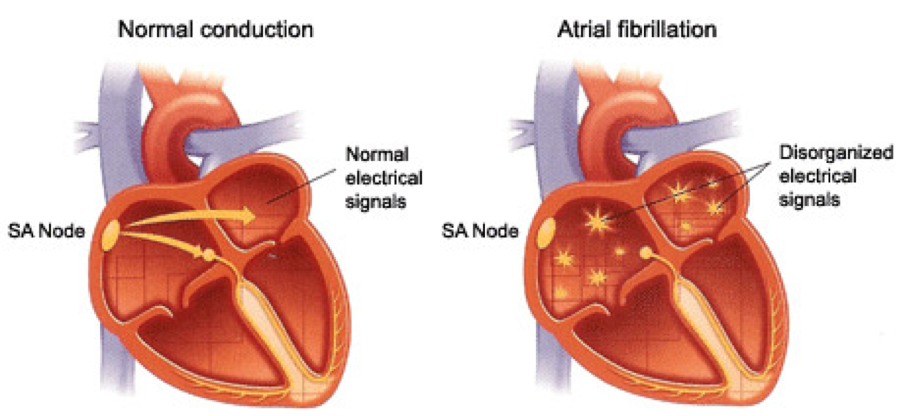The heart is a pump made up of muscle and the atria and the ventricles are the four chambers. The ventricles are the main pumps that contract to pump blood to the rest of the body. The atria act as ‘booster’ pumps to fill the ventricles and improve the efficiency of each heartbeat. The heartbeat is controlled by tiny electrical signals that start at the sinus node, a ‘timer’, in the right atrium. These signals pass through the atrioventricular node, a ‘junction’, and travel down into the ventricles, causing the heart muscle to contract.
In Atrial Fibrillation (AF) the heartbeat is irregular and may be very fast because the sinus node in the heart does not work properly. Instead of a regular electrical signal starting from the sinus node, multiple random signals ‘fire off’ from the heart muscle in the atria. This causes the atria to fibrillate in a muddled way, so that they no longer effectively pump blood into the ventricles. This loss of the ‘booster’ pump may reduce the flow of blood to the body, especially if the heart rate is very fast. Uncoordinated atrial contractions result in sluggish blood flow and the formation of thrombus in the atrial appendage. This predisposes to clot formation on the wall of the heart or valve leaflets, or to paradoxical embolism through right-to-left shunting, which predisposes to cardio-embolic stroke.
Courtesy of www.healthcitycaymanislands.com
Atrial fibrillation is a type of heart rhythm disorder and may occur on and off (paroxysmal atrial fibrillation) or it may continue indefinitely (persistent or permanent atrial fibrillation). The prevalence of atrial fibrillation increases with age. It is not generally life threatening, but it can cause serious problems, such as stroke, if not managed well.
Causes
Sometimes, there is no obvious cause and the heart is otherwise fine. This is known as ‘lone atrial fibrillation’ and these people are at much lower risk of stroke. The common causes of atrial fibrillation include:
- Hypertension
- Damaged heart muscle or valve
- Hyperthyroidism
- Heart or other major surgery
- Excessive alcohol intake
- Severe current infection, such as pneumonia
- Serious lung disease, such as a blood clot (pulmonary embolus)
Symptoms
Common symptoms include:
- Palpitations
- Shortness of breath
- Tiredness
- Light-headedness
- Chest pain or tightness
- Sometimes no symptoms – this is why it is important to get regular check-ups of your heart function.
Management
Atrial fibrillation (AF) is often an incidental finding during a routine medical assessment and the diagnosis is confirmed with an electrocardiogram (ECG). To manage the condition, the focus will be on controlling the heart rate or rhythm using medications such as beta-blockers, calcium channel blockers, digoxin and amiodarone. It is beneficial to get regular check-ups at your General Practitioner (GP) in order to detect these conditions incidentally prior to symptom development.
References
Nattel, S. (2001). The pathophysiology of atrial fibrillation. Journal of Cardiac Electrophysiology Review, 5(1), 162–165.
Porth, C. M., & Matfin, G. (2009). Pathophysiology: Concepts of altered health states (8th ed.). Philadelphia: Lippincott, Williams & Wilkins.
Dr Sarkaw Mohammad (Chiropractor)
www.hillcrestspinal.co.nz







